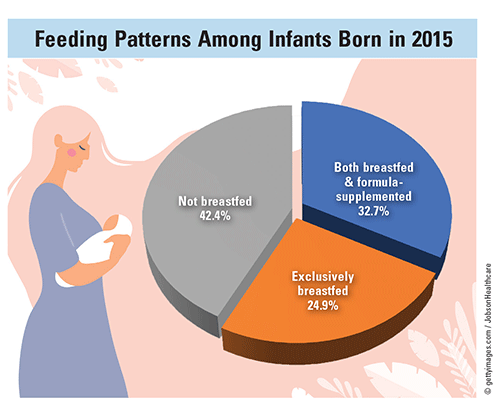US Pharm. 2021;46(8):14.
The American Academy of Pediatrics recommends that infants be exclusively breastfed for the first 6 months, with breastfeeding continuing to at least age 1 year while complementary foods are being introduced. According to the National Immunization Survey, among infants born in 2017, 84.1% were ever breastfed, whereas 58.3% and 35.3%, respectively, were still being breastfed at ages 6 months and 12 months; these rates were higher than for infants born in 2014. However, the proportion of breastfed infants dropped from 84.1% at birth to 14.6% by 18 months. The Healthy People 2030 target is to increase the exclusive-breastfeeding rate in infants through age 6 months to 42.4% and the rate of infants breastfed at 1 year to 54.1%.

Formula Feeding: The risk of hospitalization for lower respiratory tract disease in the first year of life is more than 250% higher in formula-fed infants than in those who are exclusively breastfed for at least 4 months. Just over 19% of breastfed infants born in 2017 received formula supplementation within the first 2 days of life—an increase from 16.9% of infants born in 2016. Breastfeeding was supplemented with formula before ages 3 months and 6 months in 30.9% and 36.2% of infants, respectively.
Exclusive Breastfeeding: Among infants born in 2017, exclusive-breastfeeding rates at ages 6 months and 3 months were 25.6% and 46.9%, respectively. With age progression, there was a 59.7% decrease in exclusive breastfeeding, from 63.6% at 7 days old to 25.6% at age 6 months. The rate of exclusive breastfeeding was higher among infants aged 6 months who were not firstborn children (27.5%) than in infants who were firstborn children (22.3%).
Disparities: In terms of ethnicity, the CDC’s 2020 Breastfeeding Report Card noted that Asians had the greatest number of breastfed infants (90%), followed closely by whites (86.7%) and Hispanics (84.1%); the rate for non-Hispanic black infants was 73.7%. Among black infants, 58% were breastfed initially and 28% at 6 months, with 8% exclusively breastfed at 6 months. Infants receiving Special Supplemental Nutrition Program for Women, Infants, and Children (WIC) benefits were less likely to ever be breastfed (77%) compared with infants eligible for but not receiving WIC (82.1%) and infants ineligible for WIC (92.1%). Less disparity in breastfeeding infants occurred between mothers aged 20 to 29 years (82.4%) and those aged 30 years and older (85.2%). Infants in the Southeast were less likely to be breastfed at 6 months than those in other areas, and infants in rural areas were less likely to ever be breastfed than those in urban areas.
The content contained in this article is for informational purposes only. The content is not intended to be a substitute for professional advice. Reliance on any information provided in this article is solely at your own risk.
To comment on this article, contact rdavidson@uspharmacist.com.






